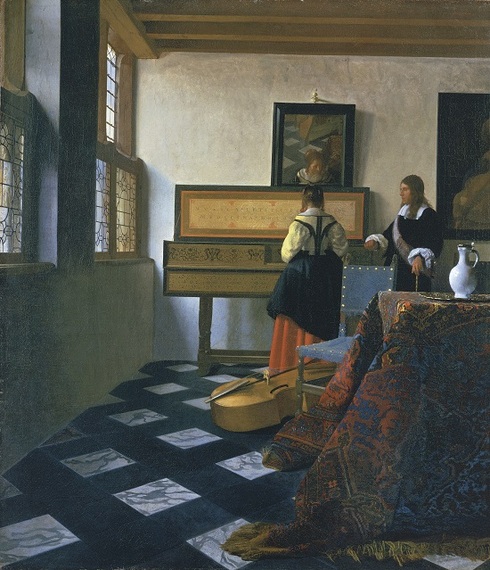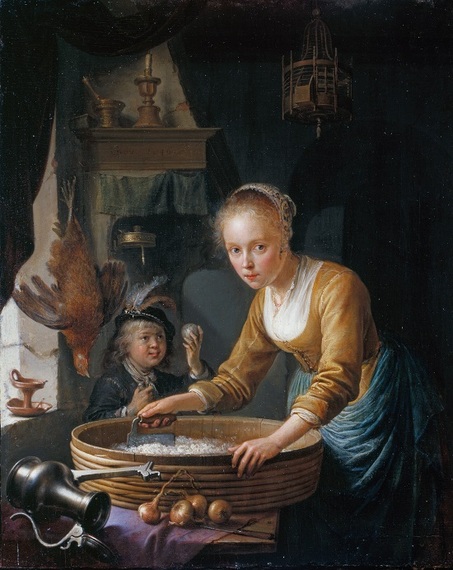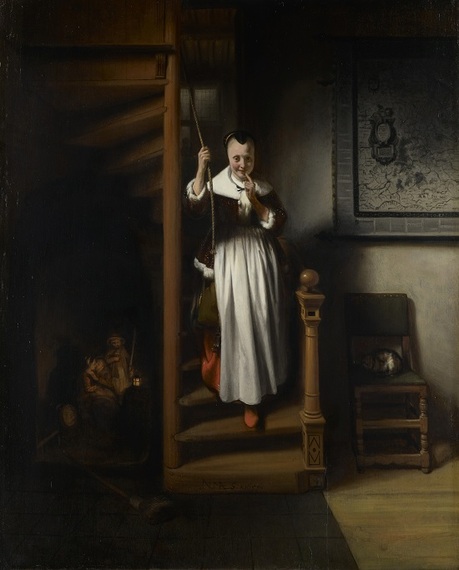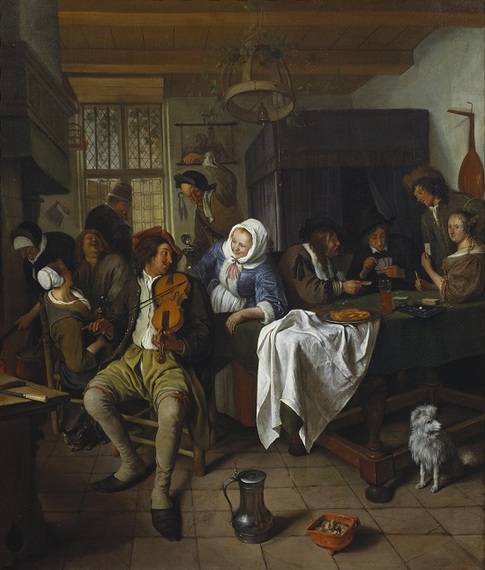In addition to superstars Rembrandt and Vermeer, the Dutch Golden Age produced a cache of artists who invented a popular art form known today as genre painting. "At Home in Holland: Vermeer and his Contemporaries from the British Royal Collection" at the Mauritshuis is a rare chance to enjoy over twenty of these snapshots of everyday life in the 17th century Dutch Republic (September 29 to January 8, 2017).

Johannes Vermeer, Lady at the Virginals with a Gentleman ('The Music Lesson'), ca. 1660-1662, Royal Collection Trust / © Her Majesty Queen Elizabeth II 2016
Assembled by successive monarchs, the paintings in the British Royal Collection usually hang behind closed doors in thirteen royal residences including Buckingham Palace and Windsor Castle. One of the last great European royal collections intact with over 7,000 paintings, the Collection is held in trust by Queen Elizabeth II.
Curators Desmond Shawe-Taylor, Surveyor of the Queen's Pictures, Royal Collection Trust, and Quentin Buvelot, head curator at the Mauritshuis, have chosen genre paintings by its best practitioners. Prized and collected by wealthy Dutch burghers, the works were remarkable at the time for their unremarkable subjects - rowdy peasants, flirting couples, card players and shopkeepers. The paintings were usually small, made to hang in homes, not palaces.
Most of the paintings in "At Home in Holland" were collected in the early decades of the 19th century by England's King George IV. Fond of the technique and stories behind Dutch genre painting, George IV displayed his scenes of misbehaving peasants in a palatial setting -- the grand garden façade of London's Carlton House. On one occasion, says Desmond Shawe-Taylor, the art-loving King was admiring one of his paintings by candlelight when he got a bit too close and dripped wax onto the canvas.

Gerrit Dou, A Girl chopping Onions, 1646, Royal Collection Trust/© Her Majesty Queen Elizabeth II 2016
Within Dutch genre painting, a variety of styles emerged. Talented storyteller Jan Steen produced lively, humorous scenes meant to both entertain and instruct. Gerrit Dou, an early apprentice to Rembrandt, founded the Leiden school of fine painters, known for meticulous detail and polished finish. Dou's talented pupil, Frans van Mieris, specialized in depicting attractive young women in amorous settings.
Meanwhile in Delft, Pieter de Hooch and Johannes Vermeer were focusing on light and space. In Amsterdam, Gabriel Metsu adopted the refined style of the Leiden school. Rembrandt's pupil Nicolaes Maes is best known today for intimate genre scenes like "The listening Housewife." Dressed in a white fur-trimmed jacket, the protagonist signals for us to be quiet, while her maid kisses a lover in a back room.

Nicolaes Maes, The listening Housewife, 1655, Royal Collection Trust/© Her Majesty Queen Elizabeth II 2016
As Quentin Buvelot explains in the exhibition catalogue, "Masters of the Everyday: Dutch Artists in the Age of Vermeer," Dutch genre painters often added symbols to their canvases that were immediately understood by contemporaries. Onions and oysters were considered aphrodisiacs. A skull, burning candle, or hourglass referred to the transience of life. An empty bird cage represented loss; a clock conveyed the fleeting nature of earthly pleasures.
Johannes Vermeer chose music as the symbol of love in "Lady at the Virginals with a Gentleman" (formerly "The Music Lesson"), one of just three dozen of his known paintings. Due to confusion over the signature, the painting was attributed to Frans van Mieris when George III bought it for Windsor Castle. In this enigmatic scene, the sun streams through the window onto the sleeve of a woman playing the virginal. A well-dressed man to her right appears to be singing along. The woman's face and the foot of Vermeer's easel are reflected in a mirror above the instrument.
Vermeer's tranquil interior is a dramatic contrast to the crowded scenes by Jan Steen, his prolific and influential contemporary. Steen humorously portrayed his subjects carousing, gambling, drinking and smoking as examples of how not to behave. The expression "A Jan Steen household" is still used to describe a lively, messy home.

Jan Steen, Interior of a Tavern with Card Players and a Violin Player, ca. 1665, Royal Collection Trust/© Her Majesty Queen Elizabeth II 2016
Steen, who worked in a number of cities including Leiden, The Hague, Delft, and Haarlem, dated only about ten percent of his 400 paintings. Conservators at the Mauritshuis are hoping to date his works by linking pigments from paint samples to the cities where he lived.
"At Home in Holland" is the perfect complement to the renowned Mauritshaus collection, founded by stadholders William IV and his son William V. To house the art works, William V built a gallery in The Hague next to the Prison Gate which became Holland's first publicly accessible art collection. In 1816, his son King William I bequeathed the collection to the Dutch state. Six years later, the paintings were moved to the Mauritshuis, the elegant former residence of Johan Maurits, governor-general of Brazil.
Among the Mauritshuis masterpieces are a trio of Vermeers: "Diana and her Nymphs," "View of Delft," and "Girl with a Pearl Earring." More gems await nearby in the elegant Prince William V Gallery, where some 150 works are displayed. Among the highlights of Dutch genre painting are Jan Steen's earliest dated work, "The Toothpuller" and Frans van Mieris' "A Boy Blowing Bubbles."
Kate Middleton, the Duchess of Cambridge, will get a tour of her family's collection when she stops by the Mauritshuis on October 11. Vermeer's "Lady at the Virginals with a Gentleman" will be on view at Buckingham Palace next summer.
For more information, visit https://www.mauritshuis.nl/en/discover/exhibitions/royal-collection/
Susan Jaques' biography, "The Empress of Art: Catherine the Great and the Transformation of Russia" was published by Pegasus Books in April.
